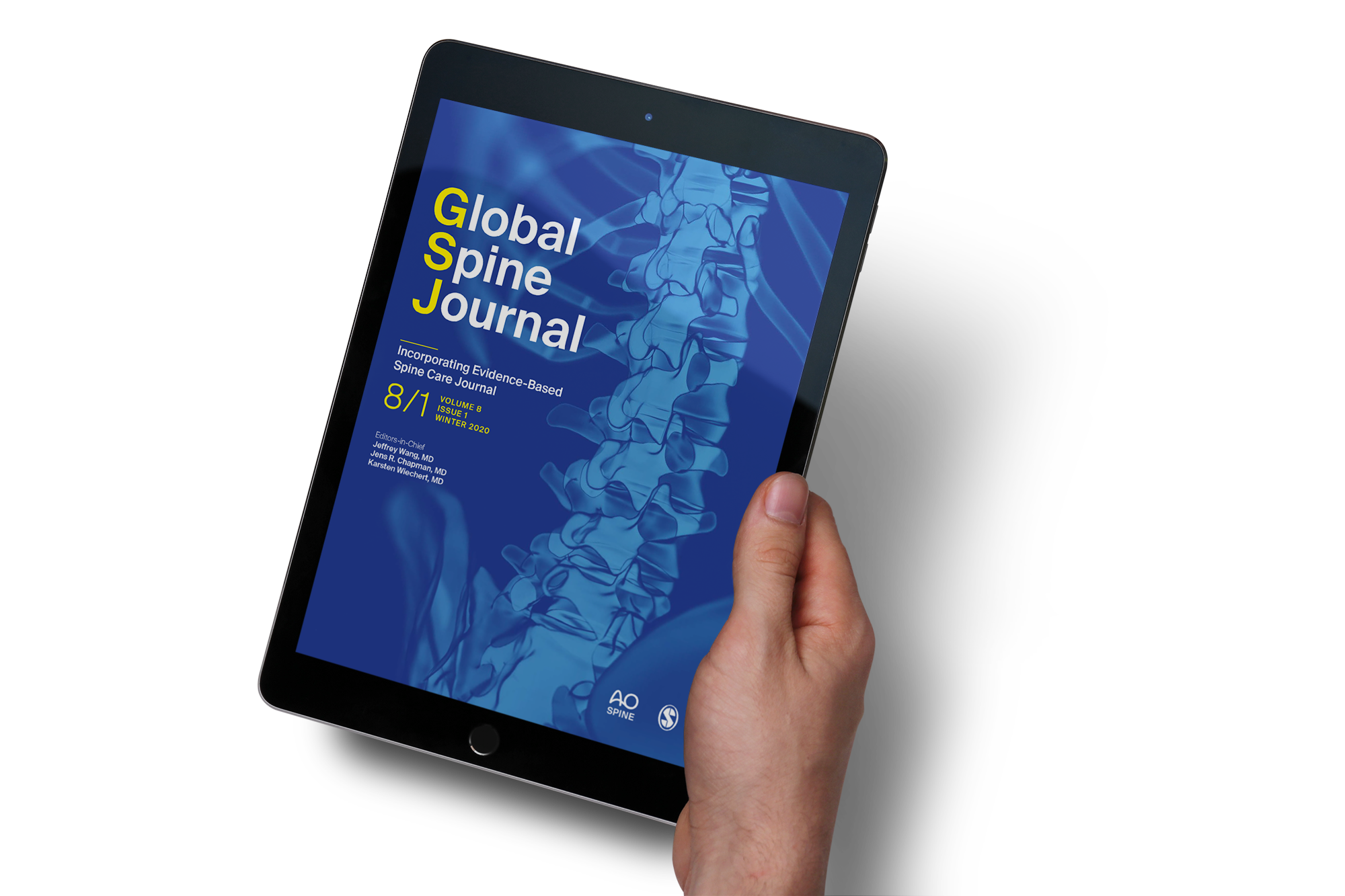

The Global Spine Journal (GSJ) has just received its first Impact Factor, which in itself is a huge milestone. The score of 2.687 in the Orthopaedics and Clinical Neurology indexes makes GSJ the second ranked spine journal and the only ranked open access spine journal. GSJ has come a long way since its beginning and is ready for the new world of scientific publishing ahead.
Originally, AO Spine had two separate, smaller journals, Global Spine Journal and Evidence-Based Spine-Care Journal, which were merged to become one journal. GSJ started out subscription-based and then moved to an open access model. Instead of the original 4 annual issues, GSJ now publishes 8 times a year. Since its beginning, GSJ has grown and flourished into the successful journal that it is today.
GSJ is led by three expert Editors-in-Chief, who set the aims and scope of the journal and have molded and shaped it into the journal it is now. Here, they discuss GSJ, the impact factor, Open Access, and the future for publishing.
Our vision is to make GSJ the most trusted and relevant go-to source of information for Spine surgeons of all specialties around the world.
Getting the Impact Factor is obviously a huge deal and is the culmination of a concerted effort of a lot of dedicated people over a long time. Members of the Editorial Team at GSJ have increasingly been peppered with questions about the Impact Factor over the years now and getting this recognition from a leading private third-party analytics organization like Clarivate cannot be overemphasized. This success, of course, would not have happened without the support and trust of our thousands of submitting authors and dedicated volunteer reviewers who now can see their efforts being validated.
What will change? Nothing will change in terms of our vision to make GSJ the most trusted and relevant go-to source of information for Spine surgeons of all specialties around the world. What we need to be prepared for is that by being the second highest ranked spine journal, and the top ranked open access spine journal, many authors may make GSJ their primary target journal for publication. This may stretch our resources and commitment to providing timely and quality responses to our submitting authors substantially and that is something we are preparing for.
Our AO Spine authors have become a relevant part of the international spine research world.
We have been so pleased to see an increasing number of presenters at meetings around the world quoting GSJ articles and systematic reviews and thus increasing the respectability and recognition of AO Spine. Our Impact Factor is in part also calculated by how often our GSJ articles are quoted and cited by others—and it seems that our AO Spine authors have become a relevant part of the international spine research world. After a decade of persistent work AO Spine now finally has a recognized flag ship academic publication to be collectively proud of.
Our core values—being responsive to our AO Spine membership by providing high value and interesting articles and studies that have received prompt and meaningful peer review—remain unchanged. We hope to be able to bring a more meaningful research output to regions that traditionally have not been on the forefront of scientific publications. And of course—our competitive nature aspires for us to be the recognized ‘number one’ publication in the spine arena in the not too distant future! Another hot topic is diversification of scientific output—using more video content and allowing for timely end-user input, for instance by publishing polling data and to provide more large integrated database analyses. These are some of the interesting opportunities that we are exploring. And, of course, we are always happy to receive suggestions from our fellow members. We really hope that our AO Spine members around the world are proud of their publication and the recognition it has received now with the Impact Factor and will receive in the future for other breakthroughs.
Another hot topic is diversification of scientific output.
This has been a big deal for us from very early on. The big trends in publishing have been to have more articles pushed out in the digital space at an ever-faster pace. The business models of the traditional publishing empires, however, have been to control access and charge premium prices for their full content, making affordability a big hurdle for individuals.
Part of our global mission of making quality spine surgery available to all in need is to provide high-end information access to all who are interested in the subject matter without placing artificial obstacles in their way. It is the beauty of the AO Foundation mission and their support in the beginning that we had the opportunity to provide an open platform for our GSJ peer reviewed work to be seen by anyone interested around the world without filters or unlimited credit card balances.
This is a daunting question to try to predict the publishing future if one considers how print journals and physical libraries have become historical relics of the past just over the last decade and we are now looking at handhelds as our primary information medium. Of course, any and all information is becoming increasingly available at moment’s notice on multiple digital media outlets, unfortunately paired with many opportunities to manipulate the output while checks and balances to prevent misuse are lagging behind.
One of the biggest challenges for scientific journals is going to be the ability to democratize research and publish ever larger impactful as well as validated studies that help us to be better health care practitioners for the benefit of our patients, wherever we are in the world. The threat is to differentiate genuine quality research from rubbish published in predatory print-for-fee outlets or by potentially fraudulent enterprises such as recently seen in some highly publicized COVID-19 related studies published and later retracted in Lancet and New England Journal of Medicine.
One of the biggest challenges for scientific journals is the ability to democratize research.
Publishers will have an increasingly important role in this by taking greater responsibility for their content, for instance by auditing research efforts and by being held more accountable for their published content in the future. This, for instance, will mean greater transparency in research data tables provided as well as more interactions of primary research staff at scientific journals and study researchers to assure data and methodological validity.
In the rush to publish, quality and thoughtfulness will ultimately prevail, but the road there will be thorny with mistakes made and regulations evolving. On the publishing front the era of digital publishing has opened completely new doors—such as interactive video-based presentations and learning opportunities and being able to poll and track the impact of publications in an unprecedented fashion. These are terrific opportunities we at GSJ can explore together with our colleagues in AO Spine.
All of us at GSJ love what we do—and we do have to digest tons of information out there in the relatively short time we have outside of our busy practices and family lives. Everyone on our Editorial Team has their own tips and preferences. Here are some samples from the Editors-in-Chief:

“I’ve always loved reading scientific articles and I like putting myself into authors’ minds as to what they are trying to say. If I detect a clear bias from the onset I will probably be pretty rapidly turned off, but if I sense that an author really is curious about a subject and is trying to find an answer not to prove a point, but to advance our understanding of the topic and to help solve a real problem I will be very interested in reading it to the end and supporting its publication.”
Karsten Wiechert

“I simply love what I do and through my involvement with a number of societies and other journals over many years I have to look at literally thousands of abstracts every year. With that I have developed a general sense of awareness of the potential of an article to impact spine care and will follow those projects through publications and presentations later on. A well written study hypothesis with a clever topic combined with a solid abstract has a much better chance of getting recognized rather than a dull data crunching exercise with a muddled message."
Jeffrey C. Wang

“What really works for me is to categorize studies by impact potential and personal interest. Studies that address major hot button topics, for instance patient safety, or comparative effectiveness studies and anything of personal interest are ‘must read’ status for me. Beyond that I scan articles for interesting questions in their title. After that I become more generalized in looking for well-done guidelines, systematic reviews and metanalyses to check for trends and insights gained (and frequently can’t help myself in finding shortcomings in what was published).”
Jens R. Chapman
Jeffrey C. Wang, MD runs the GSJ section of the journal. Dr. Wang is the Chief of Spine Service and Co-Chair of the Spine Center at the University of Southern California in Los Angeles, California.
Jens R. Chapman, MD is in charge of the EBSJ special section. Dr. Chapman is a spine surgeon at the Swedish Neuroscience Institute in Seattle, Washington.
Karsten Wiechert, MD oversees the marketing, community development and strategic planning of GSJ. Dr. Wiechert is Co-Chair of the Spine Center of the Schoen-Clinic Munich Harlaching, Germany.
Follow GSJ on social media: Facebook | Twitter